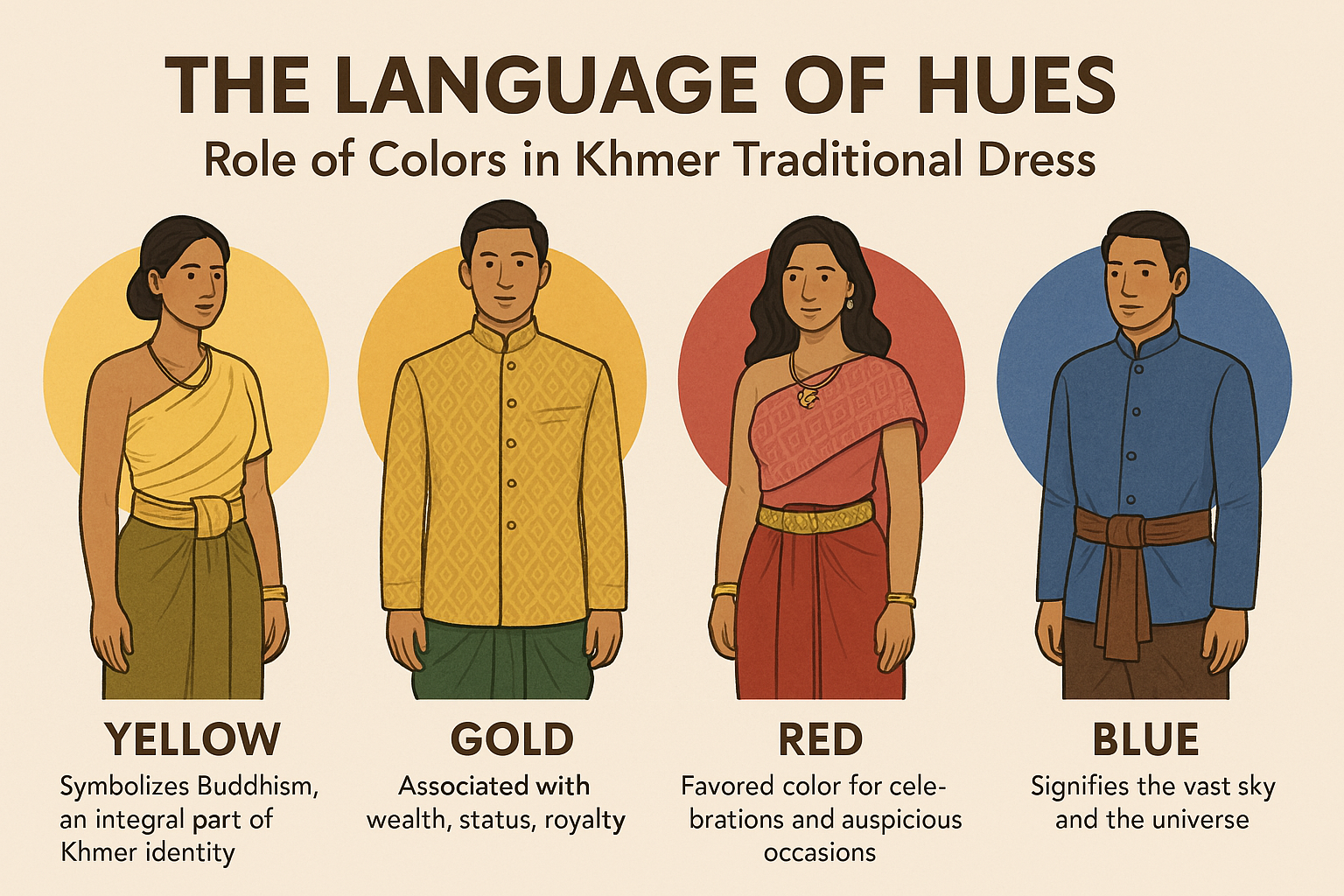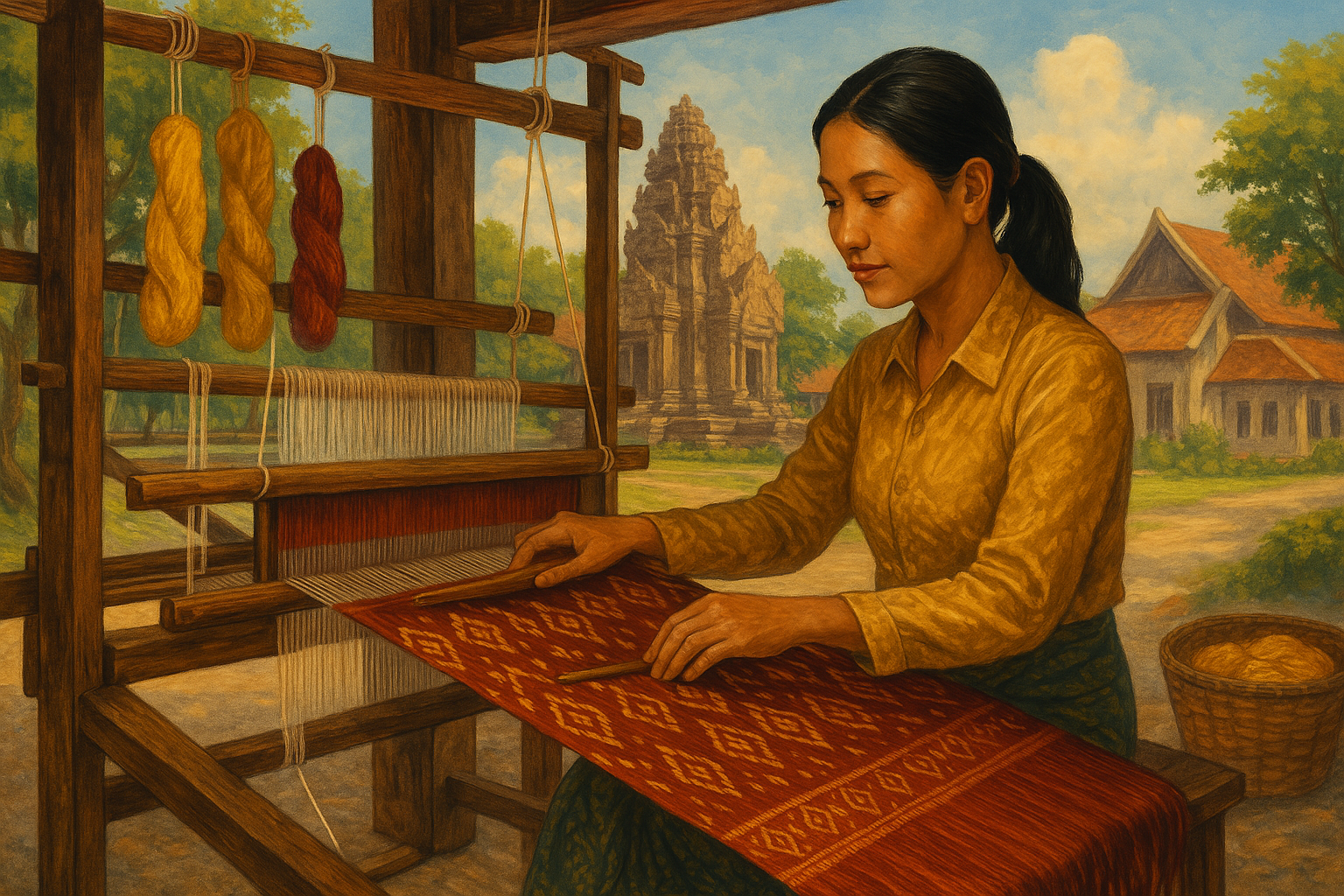In Cambodian culture, color speaks volumes. Far from being mere decoration, the hues used in traditional Khmer dress form a rich, non-verbal language, conveying messages about religious belief, social status, occasion, and even cosmological connections. Understanding this symbolism adds depth to the appreciation of Cambodian textiles and attire, a visual language readily observable in daily life and ceremonies across the country, from rural villages to bustling provincial centers like Battambang.
A Spectrum of Meaning: General Color Symbolism
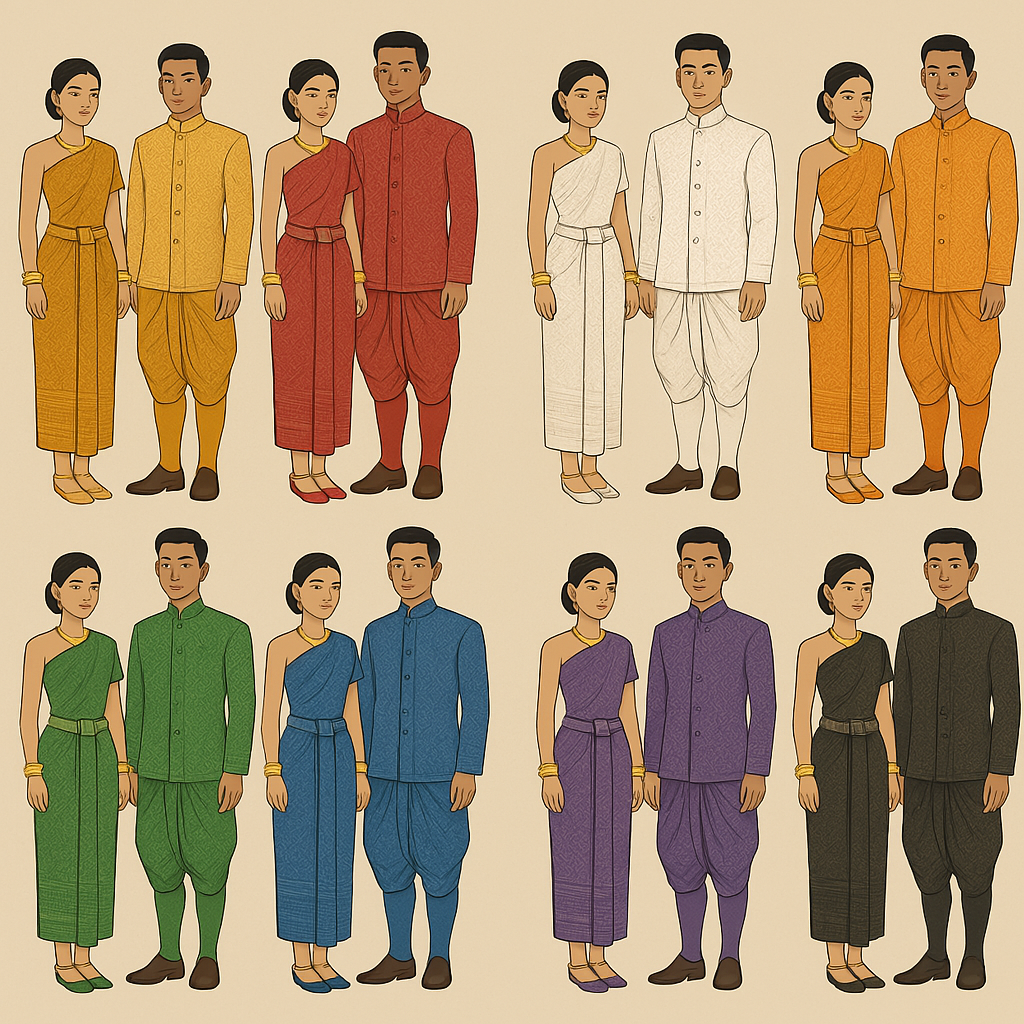
While context is always key, certain colors carry common symbolic associations in Khmer culture:
- Yellow/Gold: Universally linked to royalty, divinity, sacredness, prosperity, and Buddhism.
- Red: Represents power, bravery, courage, celebration, good fortune, and life force, but can sometimes signify anger or danger.
- White: Symbolizes purity, peace, truth, and mourning. It is also sometimes associated with ghosts or spirits in folklore.
- Orange/Saffron: Strongly associated with Theravada Buddhism, representing enlightenment, wisdom, and detachment.
- Green: Linked to nature, agriculture, fertility, growth, and hope.
- Blue: Often represents calmness, stability, reliability, and sometimes the vastness of sky or water. Can occasionally be used in mourning contexts, though less common than white or black.
- Purple: Historically associated with royalty, luxury, and spirituality, partly due to the traditional difficulty and expense of creating purple dyes.
- Black: Can signify mourning, evil, or darkness, but also power, formality, and sophistication in more modern interpretations.
The Sacred Hue: Why Buddhist Monks Wear Saffron

The distinctive saffron-to-ochre colored robes (chivor – ចីវរ) worn by Theravada Buddhist monks are deeply symbolic. Their origin lies in the Buddha’s time, when monks were instructed to make robes from unwanted or “pure” cloth (discarded fabric found in rubbish heaps or cemeteries). They dyed this cloth using natural materials readily available – such as roots, bark (like jackfruit wood), leaves, flowers, or spices – which typically produced earthy tones ranging from yellowish-brown to deep orange. This practice signifies:
- Detachment: Renunciation of vanity and materialism.
- Simplicity: Living an ascetic life according to monastic discipline (Vinaya).
- Identification: Clearly marking their role within the religious community (Sangha). The exact shade can vary slightly depending on the specific dye used, regional tradition, or monastic order, but the saffron/ochre range remains the standard for Theravada monks seen daily throughout Cambodia.
Purity in Passing: White Clothing for Funerals
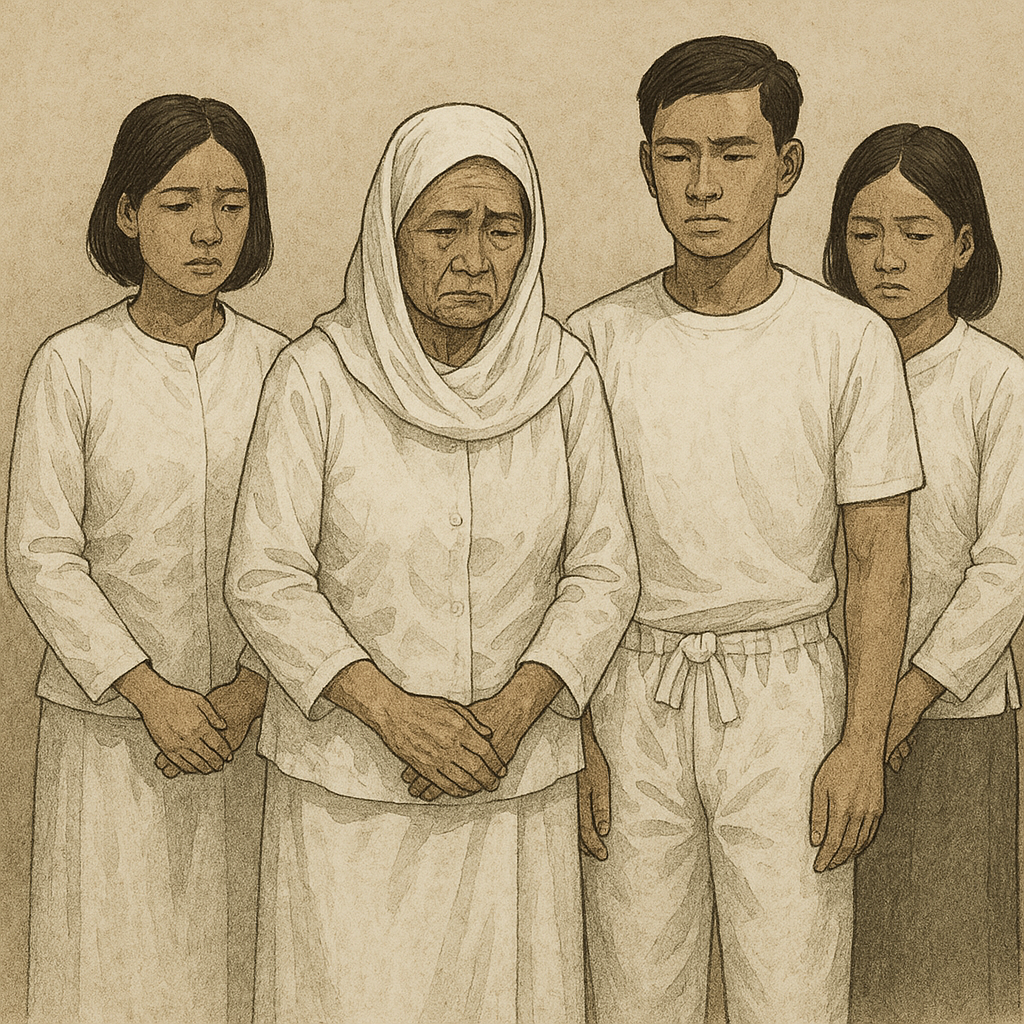
In contrast to the black often worn in Western cultures, white is the predominant color of mourning in Cambodia. Family members of the deceased, as well as other mourners attending funeral ceremonies, traditionally wear white attire. This symbolizes:
- Purity: Respect for the deceased and the purity of the spirit in its transition.
- Grief and Respect: Clearly identifies individuals participating in the mourning rites.
- Simplicity: Reflects a somber, unadorned state appropriate for the occasion.
Regal Radiance: Gold, Red, and Purple in Ceremonial Dress
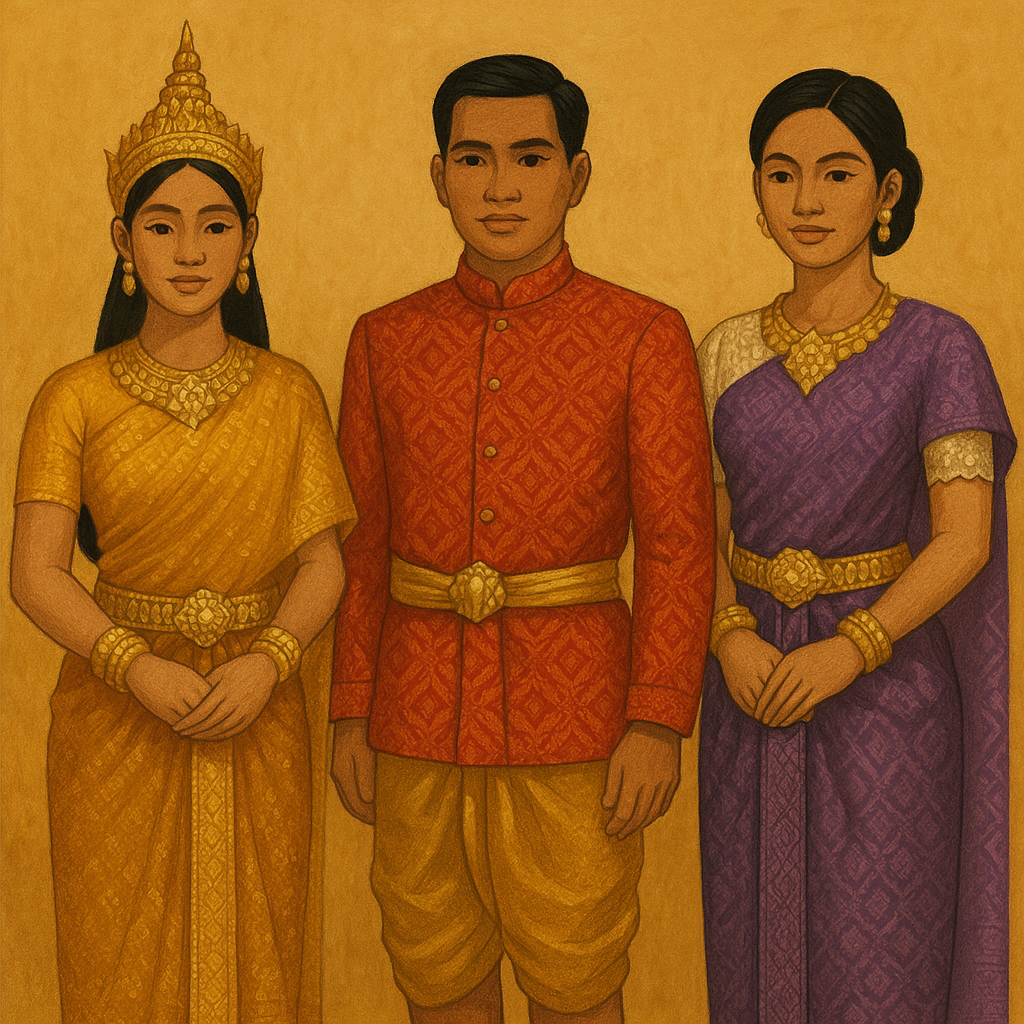
Certain colors are reserved or predominantly used for festive and high-status occasions, particularly weddings and royal events:
- Gold/Yellow: As the color of royalty and divinity, gold (often represented by gold thread embroidery – saai meas, gold fabrics, or gold-toned jewelry) is paramount in wedding attire and historical court dress. It signifies blessings, prosperity, and elevates the wearer.
- Red: A vibrant color associated with celebration, good luck, and vitality, red features prominently in festive decorations and sometimes as accent colors in wedding attire or traditional performance costumes.
- Purple: Historically a rare and expensive dye to produce, purple became associated with royalty, luxury, and high status. Rich purple silks (Sampot Phamuong or Hol) are often chosen for formal wear and significant ceremonies, conveying elegance and prestige.
Cosmic Colors: Astrology and the Days of the Week
Traditional Khmer culture incorporates an astrological system (influenced by Indian Hindu traditions) that assigns a specific color to each day of the week, based on its ruling celestial body:
- Sunday (ថ្ងៃអាទិត្យ – Thngai Athit) / Sun: Red (ពណ៌ក្រហម – Poa Kraham)
- Monday (ថ្ងៃច័ន្ទ – Thngai Chan) / Moon: Yellow or Orange (ពណ៌លឿង – Poa Lueng / ពណ៌ទឹកក្រូច – Poa Teuk Krouch)
- Tuesday (ថ្ងៃអង្គារ – Thngai Angkea) / Mars: Purple (ពណ៌ស្វាយ – Poa Svay)
- Wednesday (ថ្ងៃពុធ – Thngai Put) / Mercury: Light Green or Grey-Green (ពណ៌បៃតងខ្ចី – Poa Baitang Khchey / ពណ៌ស៊ីម៉ងត៍ – Poa Simang)
- Thursday (ថ្ងៃព្រហស្បតិ៍ – Thngai Prohoas) / Jupiter: Green or Grey (ពណ៌បៃតង – Poa Baitang / ពណ៌ប្រផេះ – Poa Prophes)
- Friday (ថ្ងៃសុក្រ – Thngai Sok) / Venus: Blue (ពណ៌ខៀវ – Poa Khiev)
- Saturday (ថ្ងៃសៅរ៍ – Thngai Sau) / Saturn: Black, Burgundy or Dark Purple (ពណ៌ខ្មៅ – Poa Khmao / ពណ៌ទុំ – Poa Tum)
Traditionally, some Cambodians might choose to wear the color associated with the current day to attract good fortune or align themselves with the day’s energy, although this practice may be less strictly observed today, it remains part of cultural knowledge.
Reflections in Fabric: Color, Status, and Belief

Color choices in traditional Khmer dress serve as indicators of various social and personal factors:
- Social Status: Historically, the ability to wear fine silks dyed in vibrant, rare, or auspicious colors like gold, deep purple, or complex multi-colored Hol patterns was a clear marker of wealth and high social standing.
- Religious Role/Belief: The monk’s saffron robe instantly signifies religious commitment and adherence to the Vinaya. Wearing white during funerals demonstrates participation in mourning rituals and respect for tradition.
- Occasion: Bright, auspicious colors dominate celebrations like weddings and Khmer New Year, while white signifies mourning, and specific colors might be chosen for other ceremonies.
- Personal Beliefs: Choosing to wear the color of the day reflects an individual’s connection to traditional astrological beliefs.
Conclusion
Color in Cambodian traditional dress is a rich symbolic code, far more meaningful than simple aesthetics. It communicates reverence for Buddhism, respect for the departed, the splendor of royalty and celebration, connections to ancient astrological beliefs, and nuances of social standing. From the ubiquitous saffron robes of monks walking the streets of Battambang to the dazzling gold attire of a wedding party or the somber white of funeral attendees, this language of hues continues to permeate Khmer culture as of 2025, adding depth and significance to the nation’s visual heritage.

